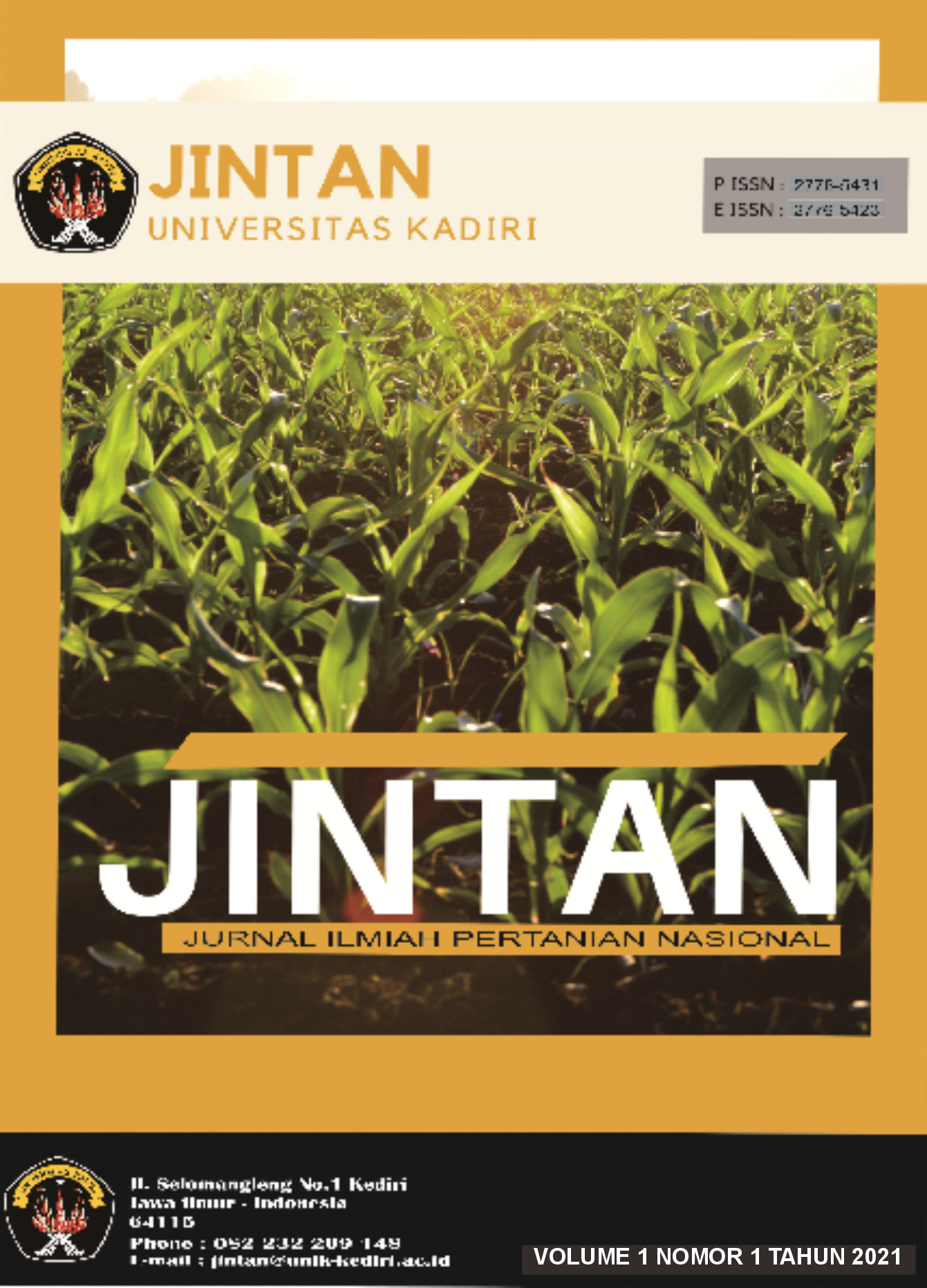Studi Komparatif Pendapatan Petani Padi Sawah Organik Dan Petani Padi Sawah Non-Organik
DOI:
https://doi.org/10.30737/jintan.v1i1.1393Keywords:
Cost, Income, RiceAbstract
Increasing food needs strongly encourages farmers to increase productivity and develop food diversity. Farmers conduct production intensification, but they do not realize that the unbalanced use of inorganic fertilizers and pesticides give a negative impact on the environment. Therefore, the organic farming system is the solution. The emergence of the organic farming product was assumed to be good for both the health and the environment. There are some considerations that the community reluctant to buy the organic product. One of the reasons is the higher purchasing price of the organic product compared to the inorganic farming product. The purpose of this research was to know the cost of the cultivation and income received from organic rice farming and inorganic rice farming in Detubapa, Wolofeo village, Detusoko district. The results of the research show that the average cost of farming in organic rice farming less than inorganic rice farming. On the other hand, the income of farmers organic rice farming greater than inorganic rice farming.
Â
Meningkatnya kebutuhan pangan sangat mendorong insan pertanian untuk meningkatkan produktivitas tanaman serta mengembangkan keanekaragaman bahan pangan. Petani melakukan berbagai cara untuk mengembangkannya. Namun, mereka tidak menyadari bahwa penggunaan pupuk dan pestisida anorganik yang tidak tepat akan mengakibatkan perubahan keseimbangan sehingga berdampak negatif bagi petani dan lingkungan. Berdasarkan kondisi tersebut petani berusaha mencari teknik bertanam secara aman dan baik untuk lingkungan sehingga muncul sistem pertanian organik. Munculnya berbagai produk pertanian organik yang di anggap baik untuk kesehatan dan lingkungan, ternyata tidak membuat semua orang beralih ke produk tersebut. Terdapat beberapa pertimbangan yang menyebabkan masyarakat enggan untuk membeli produk organik. Salah satunya adalah faktor harga beli produk organik relatif lebih mahal dibandingkan dengan produk non organik. Tujuan penelitian ini untuk mengetahui biaya usahatani serta pendapatan yang di terima usahatani padi sawah organik dan padi sawah non organik di Dusun Detubapa Desa Wolofeo Kec Detusoko. Dari hasil penelitian diketahui bahwa rata-rata biaya usahatani yang di keluarkan petani padi sawah organik lebih kecil dibandingkan petani padi sawah non organik. Selan itu, pendapatan yang diperoleh petani padi sawah organik lebih besar daripada pendapatan yang diterima petani padi non organik.
References
Apriani, M., Nahraeni, W., & Yoesdiarti, A. (2020). Analisis Pendapatan Usahatani dan Efisiensi Kelembagaan Pertanian Padi Organik dan Anorganik di Desa Lembangan Kecamatan Sukaraja Kabupaten Sukabumi. Jurnal Agribisains, 6(1), 1–13.
Artini, W. (2017). Kebutuhan Petani Untuk Pengembangan Usahatani Padi Organik (Studi Kasus Terhadap Kelompok Petani Padi Organik di Kabupaten Kediri). Agrinika, 1(1), 12–26.
Domiah, A., & Januar, J. (2019). Studi Komparatif Usahatani Padi Semi Organik Dan Konvensional Di Desa Watukebo Kecamatan Blimbingsari Kabupaten Banyuwangi. JSEP (Journal of Social and Agricultural Economics), 11(3), 56. https://doi.org/10.19184/jsep.v11i3.9146
Machmuddin, N. (2016). Analisis Efisiensi Ekonomi Usahatani Padi Organik dan Konvensional. Ipb.
Patten, M. L., Galvan, M. C., Patten, M. L., & Galvan, M. C. (2019). Random Sampling. In Proposing Empirical Research. https://doi.org/10.4324/9780429463013-35
Rahayu, M. D., & Yuliawati. (2020). Pendapatan dan Resiko Usahatani Padi Organik dan Non Organik di Karangasem, Ketapang, Susukan, Kabupaten Semarang. Ziraa’ah, 45(1), 45–53.
Sidhi, E. Y., & Samurti. (2018). Analisis Peranan Program Pengembangan Usaha Agribisnis Pedesaan (PUAP) terhadap Peningkatan Produksi dan Pendapatan Usahatani Padi (Studi Kasus Desa Mekikis Kecamatan Purwoasri Kabupaten Kediri). Agrinika, 2(2), 115–126.
Sunyoto, D. (2011). Analisis Regresi dan Uji Hipotesis. In Buku seru.
Suratiyah, K. (2015). Ilmu Usahatani. In Jakarta.
Sutiknjo, T. D., & Artini, W. (2020). Optimalisasi Dan Pemerataan Pendapatan Petani Pada Usahatani Padi Sistem Bagi Hasil. Jurnal Agrinika: Jurnal Agroteknologi Dan Agribisnis, 3(2), 92–106. https://doi.org/10.30737/agrinika.v3 i2.726
Downloads
Published
Issue
Section
License
Authors who publish in this journal agree to the following terms:
- Authors retain copyright and grant the journal right of first publication with the work simultaneously licensed under a Creative Commons Attribution License (https://creativecommons.org/licenses/by-nc-nd/4.0/) that allows others to share the work with an acknowledgment of the work's authorship and initial publication in this journal. Permitted third party reuse is defined by the Creative Commons Attribution-NonCommercial-NoDerivs (CC BY-NC-ND). This permission allows users to copy and distribute the Article, provided this is not done for commercial purposes and further does not permit distribution of the Article if it is changed or edited in any way, and provided the user gives appropriate credit (with a link to the formal publication through the relevant DOI), provides a link to the license, and that the licensor is not represented as endorsing the use made of the work.
- Authors are able to enter into separate, additional contractual arrangements for the non-exclusive distribution of the journal's published version of the work (e.g., post it to an institutional repository or publish it in a book), with an acknowledgment of its initial publication in this journal.
- Authors are permitted and encouraged to post their work online (e.g., in institutional repositories or on their website) prior to and during the submission process, as it can lead to productive exchanges, as well as earlier and greater citation of published work.
- For open-access publishing, authors have the right to share their articles in the same ways permitted to third parties under the relevant user license, as well as certain scholarly usage rights.
Deprecated: json_decode(): Passing null to parameter #1 ($json) of type string is deprecated in /home/ojs.unik-kediri.ac.id/public_html/plugins/generic/citations/CitationsPlugin.php on line 68




